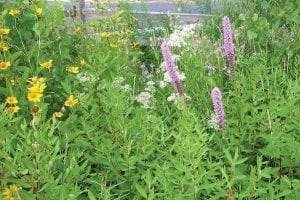Whether living on a lake or river, in the city or in the country, the way lawns are maintained affects the water quality in Minnesota’s watersheds.
Lawns are one source of nutrient, pollutant, and sediment run off.
Shoreland lawns, especially those that go right to the water’s edge, allow runoff directly into the lake or river. Lawn fertilizers, high in nitrogen to make the grass green, can cause excessive aquatic vegetation and make the lake green.
Grass clippings that get into the lake or river may cause algae growth by releasing phosphorous as they decompose. Also, soil runoff can negatively affect fish spawning areas.
Shoreland property owners can reduce runoff by adding a vegetative buffer strip along the water’s edge. A buffer of native plants with deep roots slows the rate of run off, traps sediments, absorbs nutrients and reduces erosion.
A simple way to create a buffer is to stop mowing and allow native plants to return. Some of these plants may have been dormant. If not, the next step is to plant more native plants.
Lawns in the city allow rainwater to runoff into storm sewers, which may eventually run into streams, rivers and lakes. Installing a rain garden will help fix this problem. A rain garden built into a low area of the lawn will capture runoff and hold it for short periods of time, allowing water to percolate into the water table and giving plants a chance to absorb nutrients. There are many resources on the internet with instructions on building a rain garden.
Vegetative buffers and rain gardens can range from natural to formal.
However it is best to use native plants whenever possible. They reduce the chance that unwanted, non-native species will take over. Also they offer habitat for birds, insect pollinators and wildlife. Once established, native plants often require little maintenance and provide eye-catching color to your landscape.
Everything we do on the land impacts our waters.
Learn more by visiting the Minnesota Department of Natural Resources Web site at www.mndnr.gov.



Loading Comments